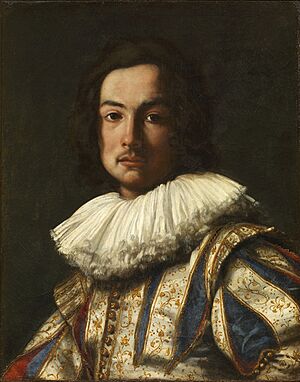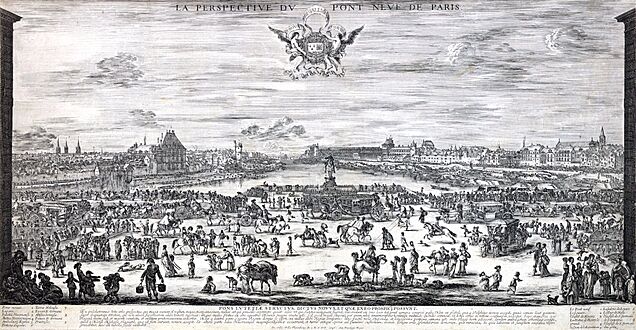Stefano della Bella facts for kids
Quick facts for kids
Stefano Della Bella
|
|
|---|---|

Portrait by Carlo Dolci
|
|
| Born | 18 May 1610 |
| Died | 12 July 1664 (aged 54) |
| Nationality | Italian |
| Known for | Engraver |
| Movement | Baroque |
Stefano della Bella (born May 18, 1610 – died July 12, 1664) was a talented Italian artist. He was famous for his many etchings, which are a type of printmaking. Stefano created over a thousand prints and thousands of drawings. His artworks showed all sorts of things, like scenes from courts and armies, beautiful landscapes, and lively everyday life. He was born and passed away in Florence, Italy.
Contents
Stefano's Early Life in Florence
Stefano della Bella was born into a family of artists in Florence. He first learned to be a goldsmith, someone who works with gold. Later, he became an engraver, an artist who carves designs onto metal plates to make prints. He learned from teachers like Remigio Cantagallina, who also taught another famous artist named Jacques Callot. Because of this, Stefano's early prints looked a lot like Callot's.
When Stefano was seventeen, he showed an etching of a big party at the Palazzo Pitti to a young prince, Giancarlo de' Medici. The powerful Medici family was so impressed that they started giving Stefano official art jobs.
In 1630, when he was twenty, Stefano copied a famous book by Leonardo da Vinci called Trattato della Pittura (Treatise on Painting). He added about 50 of his own sketches to his copy. A long time later, in 1792, his special copy was published with all his drawings.
By 1632 or 1633, Stefano received direct support from Lorenzo de' Medici, who was Giancarlo's uncle. Stefano asked Lorenzo if he could go to Rome to become an even better artist.
Working as an Artist in Rome
Stefano della Bella moved to Rome in 1633 and stayed there for six years to study and create art. He lived in the Medici Palace. While in Rome, he drew many vedute (detailed city views) and pictures of ancient buildings. He also drew busy scenes of public events in his sketchbooks. Many of these drawings later became prints.
Stefano also helped record the grand parties and celebrations of the Medici family. During this time, his art style changed from Mannerism to Baroque. The Baroque style is known for being very dramatic and full of movement.
One of his famous works from this period is a series of six prints that form a very long picture, about 2.5 meters (8 feet) long. It shows the Polish Ambassador’s Ceremonial Entry into Rome in 1633. He also made many prints showing different views of Rome. Even while living in Rome, he often went back to Florence to complete art jobs for his clients there.
Life in Paris and Return to Florence
In 1639, Stefano della Bella moved to Paris, France, and lived there until 1650. He changed his art style to fit what French people liked. He was also influenced by artists like Rembrandt and other Dutch printmakers. Stefano even traveled to Holland and North Africa during this time.
Most of Stefano della Bella's prints were made during his years in Paris. He arrived four years after the death of Jacques Callot, and important French publishers already knew his work. In 1641, a powerful leader named Cardinal Richelieu sent him to Arras. Stefano was asked to draw the siege (when an army surrounds a town) and capture of that town by the king's army, so prints could be made. In 1644, another leader, Cardinal Mazarin, asked him to create four sets of educational playing cards for the young king, Louis XIV. Stefano's decorative prints were very new and exciting, almost like they were looking ahead to the Rococo art style.
Stefano also created prints of Paris. One very large print shows the Pont Neuf bridge. It looks south from the entrance of the Place Dauphine. The print shows buildings on both sides of the Seine River very accurately. The bridge itself is full of carriages, wagons, people, and animals. There are 451 different figures, including beggars, gypsies, musicians, children, and even people pulling teeth! There are also horses, donkeys, dogs, and a lamb.
Because of some anti-Italian feelings in France during a time called the Fronde, and the death of Cardinal Mazarin, Stefano della Bella likely returned to Florence. There, he received a regular payment from the Grand Duke. He even taught the Grand Duke's son, Cosimo III de' Medici, how to draw. Stefano continued to send his engraved plates to publishers in Paris.
Stefano della Bella is also known for illustrating some discoveries for the famous scientist Galileo Galilei. He even drew Hansken, a famous elephant, after it had passed away. In his last years, he experimented with making prints that had different shades and tones, almost like paintings. He had always used washes (thin layers of ink) in his drawings, and he tried to get similar effects in his etchings. In 1661, he seems to have had a stroke, and after that, he didn't create much more art.
Antonio Francesco Lucini was one of his students in Florence.
See also
 In Spanish: Stefano della Bella para niños
In Spanish: Stefano della Bella para niños
- Decoration for a Thesis in Honor of Saint Francis Solano





